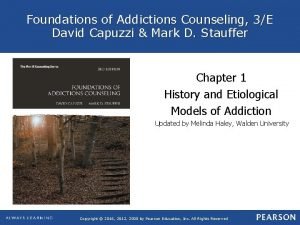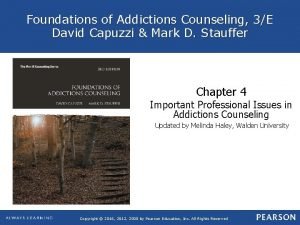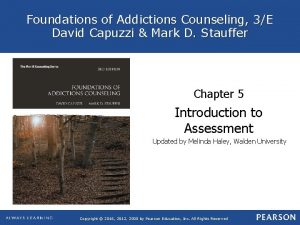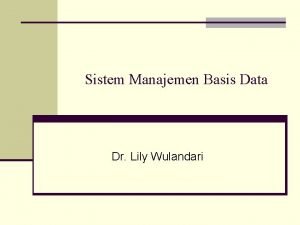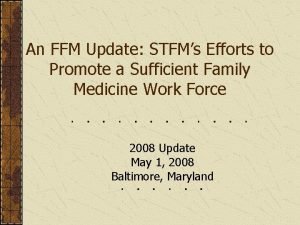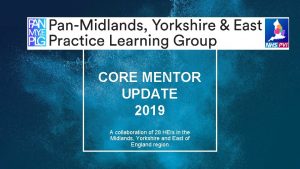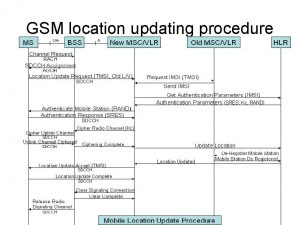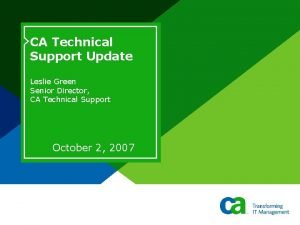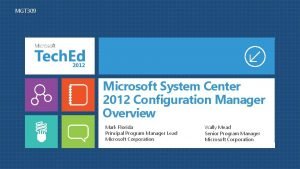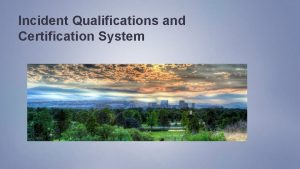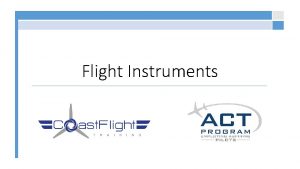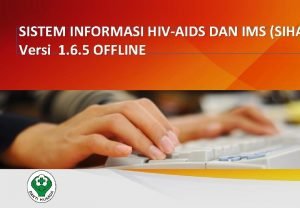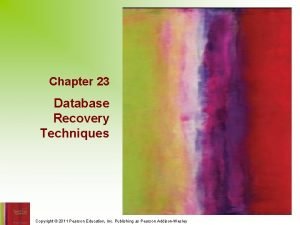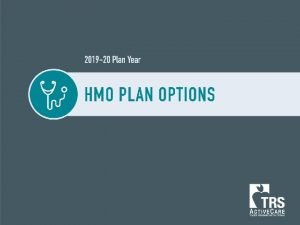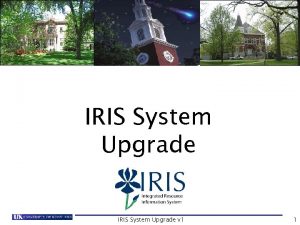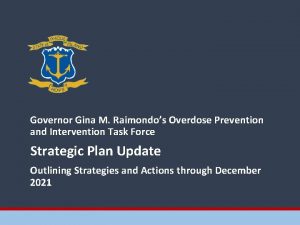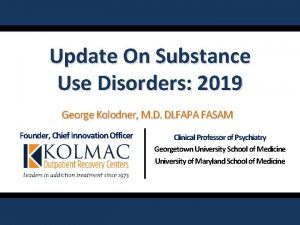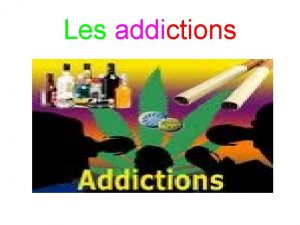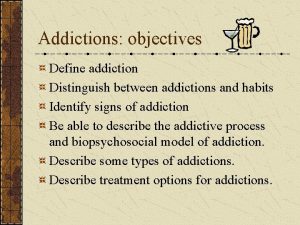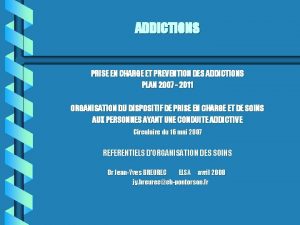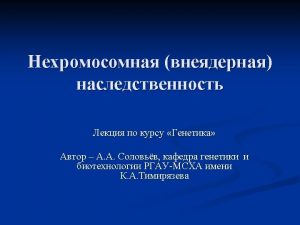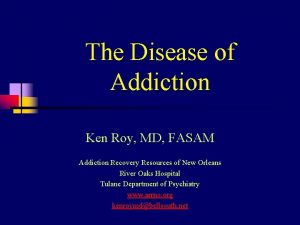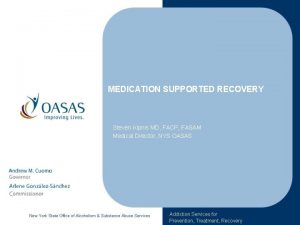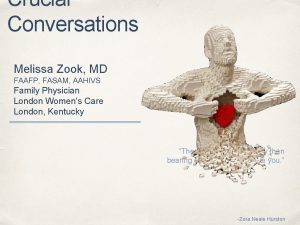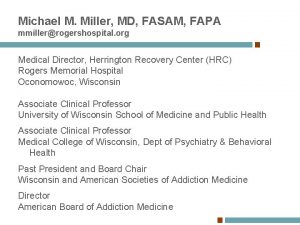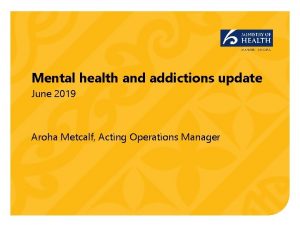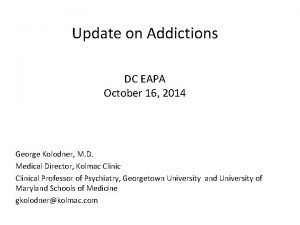Update on Addictions George Kolodner MD DLFAPA FASAM





























































- Slides: 61

Update on Addictions George Kolodner, MD DLFAPA FASAM Chief Clinical Officer Kolmac Outpatient Recovery Centers Clinical Professor of Psychiatry Georgetown University and University of Maryland Schools of Medicine

Overview • • Recent Use Patterns Opioids Cannabis Policy Issues

Percentage of People Addicted After Using A Substance 35 30 25 20 32 11 9 9 5 el ics ed yc h Ps Se da tiv es is ab Ca nn ts an l im ul St Al co ho e in Co ca in ro He Ni co tin e 0 4 nt s 5 15 la 17 ha 23 10 In 15

Risk of Addiction: Weekly Users • Nicotine: 50 – 67% – Predictors of progression from use to addiction: • Unmarried female, lower age • Anxiety disorder and absence of depression • Cannabis: 17 – 25% • Alcohol: 16% – Predictors of progression from use to addiction: • Unmarried male, nicotine addiction with lower age, income, and education • Depression but not anxiety disorder

Substance Use by Teenagers, 2016 (www. monitoringthefuture. org) • Declines for most substances – Historic lows for alcohol, tobacco, heroin, inhalants – Decreased stimulants, MDMA (“ecstasy”), cocaine • Cannabis – 8 th graders: decreased – 10 th and 12 th graders: no increase – Continued decline for synthetic cannabis (“K-2, ” "Spice") • Prescription opioids decreased • Electronic cigarettes declined for first time – Exceed conventional cigarettes

2016 Substance Use Trends: College Aged (www. monitoringthefuture. org) • Alcohol still the drug of choice – Gradual reduction since early 1980’s – Binge drinking reduced for men but not women • Cannabis is highest in 30 years – Steady increase since 2006 despite no increase in high school age youth • High level of first time users – Daily use: men more than women • Tobacco – Non-students > students

2016 Substance Use Trends: Adults (NSDUH) • Opioids – Decrease in prescription opioids – No change in heroin – Continued increase in opioid overdose deaths • Cocaine – Increased use • Also noted in work site urine screens by Quest Labs

Prescription of Benzodiazepines • Steady increase in number of prescriptions being written • Concern about interaction with opioids – FDA black box warning on co-prescribing of benzodiazepines and opioid analgesics – FDA is reviewing co-prescribing of benzodiazepines with opioids for medication assisted therapy

Changes in Substance Use by Kolmac Patients 1989 2016 Cocaine 44% 9% Opioids 6% 33% Cannabis 6% 18% Benzodiazepines 2% 8%

OPIOIDS

Opioid Epidemic: Three Waves 1. Prescription opioids 2. Heroin 3. Fentanyl, carfentanil

Rates of Opioid Sales & OD Deaths, 1999– 2013 8 7 6 5 4 3 2 1 0 1999 2000 2001 2002 2003 2004 2005 2006 2007 2008 2009 2010 2011 2012 2013 Source: National Vital Statistics System, DEA’s Automation of Reports and Consolidated Orders System

Opioid Related Overdose Deaths United States, 1999 -2013

Death Rates by Age Group from Overdoses of Heroin or Prescription Opioid Pain Relievers SOURCE: CDC. Increases in Heroin Overdose Deaths — 28 States, 2010 to 2012 MMWR. 2014, 63: 849 -854

Continued Rise in Opioid Overdose Deaths • Caused by the addition of potent synthetic opioids to heroin – Fentanyl and carfentanil (animal tranquilizer) are being produced illicitly in China rather than diverted from legitimate medical use • Overdose of Prince was on fentanyl • Third wave, after prescription opioids and heroin

Reducing Availability of Prescription Opioids • AMA recommends removing “ 5 th vital sign” • CMS removed patient satisfaction questions regarding opioid prescribing • FDA panel recommended extending REMS – Mandatory training for opioid prescribing – Instant release formulations now Included • Increased requirements for physicians to register for and use PDMPs • Increased education and convenience regarding disposal of unused medication – October 28: National Prescription Drug Take Back Day

CDC Guidelines: Prescription of Opioid Medications for Chronic Pain 1. Non-pharmacologic and non-opioid pharmacologic therapies are preferred 2. Before starting, discuss risks and benefits, reasonable goals for pain and functioning, and have plan for discontinuation 3. Begin with immediate-release instead of extended-release/long-acting (ER/LA) opioids 4. Periodically reevaluate and work to lower dose or discontinue

CDC Guidelines: Prescription of Opioid Medications for Chronic Pain 5. Use urine testing before starting and periodically thereafter 6. Use Prescription Drug Monitoring Program (PDMP) 7. Avoid using opioids for patients taking benzodiazepine medication 8. Screen for history of substance use disorder

Expanded Use of Buprenorphine • Over one million patients now taking it – Compare to quarter million on methadone • Incorporation into traditional 12 -Step based residential treatment program – Hazelden/Betty Ford project • Increased patient limit to 275 for physicians: – With addiction certification – Who have had a waiver for the 100 patient limit for at least one year – Or who practice in a qualified health setting (provide counseling and accept insurance) • NPs and PAs now allowed to prescribe (30 100)

Addressing Resistances • Treatment staff – Negative methadone experiences • Patients – Concern about getting off – “Not really in recovery” • Patient families – Negative publicity – “Exchanging one drug for another” • Addiction treatment community • Narcotics Anonymous – “Unable to work the steps” • Former HHS Secretary, Tom Price • Lobbying by Alkermes (manufacturer of Vivitrol)

Ongoing Issues With Buprenorphine • Prior authorization – Now banned in Maryland – Discontinued by Aetna, CIGNA • Stabilization doses – Vary by individual • Co-morbid pain management – Chronic – Elective surgical procedures • Discontinuing – When: task versus time based – How: protocols, Butrans patch – Relationship to long term recovery

Kratom Derived from leaves of Southeast Asian tree Active ingredient: mitragyna alkaloids Low dose: stimulant effect Higher doses: activates opioid receptors and can relieve pain • Used for centuries for medicinal purposes • Addictive use resembles opioids • Under political pressure, DEA reversed its decision to place it in Schedule 1 • •

President’s Commission on Combating Drug Addiction and the Opioid Crisis, 7/31/17 Declare national public health emergency Expand addiction treatment capacity Mandate prescriber education on opioids Fund access to medication assisted treatment, including all 3 options • Increase interstate capacity of Prescription Drug Monitoring Programs (PDMP) • Enforce parity for behavioral health • •

Declaring National Emergency? • July 31: Draft interim report released • August 1: Doubts expressed about declaring emergency • August 10: Verbal declaration • October 16: Declaration to be signed next week • Emergency declared in six states, including Maryland Virginia

CANNABIS (AKA MARIJUANA)

Benefits and Dangers: Ongoing Debate • Extreme arguments on both ends – Be aware of underlying agenda – Assess the quality of evidence

Reliable Reference • The Health Effects of Cannabis and Cannabinoids: The Current State of Evidence and Recommendations for Research • 440 page comprehensive review released January, 2017 by National Academy of Science • Download available – http: //nationalacademies. org/hmd/Reports/2017/ health-effects-of-cannabis-and-cannabinoids. aspx

1. Benefits of Medical Cannabis • Benefit is modest • Strongest evidence – Chronic pain – Chemotherapy-induced nausea and vomiting – Patient reports of spasticity resulting from multiple sclerosis • Insufficient high quality evidence – Seizures, anxiety, insomnia, irritable bowel syndrome, and PTSD

2. Dangers of Cannabis • No consensus about safe level of use • Increased incidence of motor vehicle accidents – Especially when combined with alcohol

3. Research • Substantial barriers exist in U. S. to legitimate research which impede – Resolution of controversies – Development and availability of pharmaceutical grade medical cannabis

Safety • No overdose deaths – Absence of CB receptors in brainstem • Intoxication a problem – Impaired driving • Especially if mixed with alcohol – Delayed effect • Association with psychosis – Causation possible

Impact on Driving • Recent cannabis use: twofold increase in risk of auto accidents – Blood level standard: > 5 mcg/ml • Problem separating new from residual levels – Relationship to fatal crashes controversial • Cannabis effects have greater impact on automatic driving functions • Cannabis users are more aware of being impaired and tend to compensate for impairments – Drive slowly and increase distance from other cars – Cannot compensate for emergency situations

Driving: Cannabis Plus Alcohol • Recent alcohol use: 6 to 15 times increase in risk of auto accidents • Alcohol effects have greater impact on complex tasks that require conscious control – Less tendency to compensate • Alcohol reduces use of cannabis compensation strategies – Measure increase speed and decrease distance Ø Result: impairments at levels that would be insignificant if either substance was used alone

Negative Effects on Developing Nervous System • Heavy cannabis use – Prospective study of 1, 000 from birth to 38 found cognitive deficits if heavy use began before age 18 • IQ (8 points, no recovery) • Attention (poor recovery) • Memory, processing speed, reasoning skill • In utero – Decreased head circumference – Cognitive and behavioral effects after age 4 (? ) – Colorado: increase in babies born with THC in their systems

Cannabis Withdrawal Syndrome • New diagnostic category in DSM-5 • Symptoms usually mild – Irritability, anxiety, insomnia, disturbing dreams, decreased appetite, restlessness, depressed mood • Cravings can be clinically significant • Time course – Onset 24 to 72 hours, peak within first week, duration 1 to 2 weeks • Sleep difficulties may last more than 30 days • Usually manageable with mild medication – Research: positive response to dronabinol

Netherlands Experience • Netherlands: Restriction of availability due to concern about use by tourists • Maastricht University: Increased grade point averages

Obstacles to Knowledge • Access – Single source for research grade • University of Mississippi farm, contracted by NIDA • Low THC concentration of research grade • Fall, 2016: DEA willing to allow other sources – 5 levels of approval (more than any other drug) v. DEA – not FDA – has final authority • Organizational issues – No government agency focused on beneficial uses • Discourages development of new pharmaceutical products • Endocannabinoid system is not being taught in medical schools

Availability of Cannabis for Research • Failure of Congressional bill to create new Schedule “ 1 R” for cannabis research • DEA: – Rejected changing Schedule 1 status for cannabis – Agreed to allow multiple suppliers for research grade production but approved applications have been blocked at upper levels of DOJ • NIDA is working with the DEA to reduce the administrative burdens on research – CBD will be available for research studies

Expanded Research • NIH Cannabis Neuroscience Research Summit, March 22 -23, 2016 – Recording of conference available at: https: //videocast. nih. gov/summary. asp? Live =18464&bhcp=1 • More balanced approach at American Society of Addiction Medicine Annual Meeting

Pharmaceutical: “Entourage Effect” • Sativex (1: 1 ratio of CBD/THC) – Oro-mucosal spray – Approved in 25 countries (2005) for spasticity from multiple sclerosis, cancer pain, neuropathic pain – U. S. : Phase III clinical trials, fast tracked by FDA in April, 2014 • Epidiolex (cannabidiol or CBD) – Purified liquid extract – Anticonvulsant for Dravet syndrome – Orphan Drug Status from FDA, pre-IND

Raphael Mechoulam • 86 y. o. Israeli chemist, still professionally active • Identified THC as the primary psychoactive ingredient in cannabis • Discovered the endocannabinoid system • “The Scientist”: You. Tube documentary about his discoveries – https: //www. youtube. com/watch? v=csb. Jn. BKq w. Iw

Current Legalized Status • National – Recreational use: 8 states and DC • Cannot be brought across state borders, even in adjacent states • DC – Medical use: legal – Recreational use: legal but not regulated • Maryland – Recreational use: decriminalized – Medical use: legal since 2013 • Availability expected by end of 2017

Medical Legalization History • 2013. Obama administration: Won’t challenge medical cannabis if careful state regulation • 2014. Rohrbacher-Farr Amendment (US House of Rep). Blocks DOJ from intervening – 2015. Court decision ordered DOJ to comply • 2017. Currently medically legalized in 44 states and DC

Future Cannabis Policy • Obama DOJ policy toward “medical marijuana” of “cooperative noninterference" is being reviewed by Trump DOJ • July, 2017: bill to legalize was introduced in U. S. Senate by Cory Booker

Summary • Cannabis has medicinal value – Benefits and risks tend to be exaggerated • Influence of law enforcement agencies has outweighed health agencies • Political considerations have interfered with scientific evaluation and left physicians in a disadvantaged position – Beware of selective use of data to support particular positions • Barriers to research and pharmaceutical development should be lowered

POLICY ISSUES

Reliable Reference • Facing Addiction in America: The Surgeon General’s Report on Alcohol, Drugs, and Health – https: //addiction. surgeongeneral. gov/ • Released in 2016 by Vivek Murthy

Conflicting Directions • General population: increase in favoring cannabis legalization • Obama actions • Trump/Sessions actions

War on Drugs • Initiated by Richard Nixon in 1972 – Intensified under Reagan and Clinton administrations • Wound down under Obama administration – Eliminated disparity between sentences for powdered and crack cocaine – Commuting of sentences of nonviolent drug offenders – Reduced enforcement of cannabis violations • Reversal by current AG Sessions – Increase severity of sentencing – Increased prosecution of cannabis use • Return to “Just say no. ” – Possible challenge of state medical cannabis

Leadership Ambiguities • Office of National Drug Control Policy (ONDCP, “Dug Czar”) – Created in 1972 to coordinate U. S. policy on drugs • Fluctuating emphasis on treatment and law enforcement – Previous head, Michael Botticelli, was first person openly in recovery – Current acting head: Richard Baum – Nominated head, Tom Marino, withdrawn twice • Drug Enforcement Agency (DEA) – Chuck Rosenberg resigned October 1 – Current acting head, Robert Patterson

Professional Learning Opportunities • American Society of Addiction Medicine (ASAM) Associate Membership – Access to publications, educational events – Maryland/DC Society of Addiction Medicine – $260 – Annual Meeting • Baltimore, Maryland • Saturday, November 11

Thank you George Kolodner, M. D. gkolodner@kolmac. com Follow Kolmac Blog: www. kolmac. com/category/articles

Renewed Interest in Harm Reduction • Needle exchange • Protected sites for heroin use • Decriminalization – Cannabis in Canada – All drugs in Portugal • Emphasis on treatment

TOBACCO

FDA Regulations Regarding Tobacco Addiction Treatment • Removed black box psychiatric warning on varenicline (Chantix)

E-Cigarettes (“Vaping”) • Alternative nicotine delivery system • Liquid is heated in a battery operated device that creates an aerosol that is inhaled – Not actually a vapor, but rather fine particles – No combustion, therefor many toxins absent • Liquid contains nicotine, flavoring, and other ingredients – No uniformity of product content • “Mom and pop” stores make own mixtures – Heating ingredient creates byproducts • Propylene glycol propylene oxide (carcinogen)

Youth: Shifting From Tobacco to E-Cigarettes Year Tobacco E-Cigarettes 2016 9% 13% 2011 16% 1. 5%

Concerns About Use by Youth • Some teens are starting with e-cigarettes and transitioning to regular tobacco • NIDA “ABCD” project – Prospective study of the effect of all substances on adolescent brain and cognitive development – Baseline studies being done of 9 and 10 year old's, including MRIs – Nearly 5, 000 of 10, 000 subjects have been recruited in past 12 months

ABCD: New Prospectve Study by NIDA • Adolescent Brain Cognitive Development • Goal: study the effect of all substances on adolescents • Method – Get baseline measurements of 9 and 10 year old’s before substance use starts • Brain imaging, exposure to drugs, social environment and performance at school – Follow prospectively • Progress: nearly 5, 000 of 10, 000 subjects recruited in past 12 months

E-Cigarettes: Recent Developments • New FDA regulations extends 2009 tobacco regulations to e-cigarettes, cigars, hookah and pipe tobacco – No sales to youth younger than 18 – Ingredients examined for health impact • Entry into the field by tobacco industry • Devices are being used for illicit substances

E-Cigarettes: Future Directions • Can be useful for some people who are using them to quit tobacco • Increase in harm reduction consideration – “Dangers exaggerated”
 Foundations of addictions counseling
Foundations of addictions counseling Foundations of addictions counseling
Foundations of addictions counseling Substance use addictions and related behaviours
Substance use addictions and related behaviours Foundations of addictions counseling
Foundations of addictions counseling Alternative of log based recovery
Alternative of log based recovery King george vs george washington
King george vs george washington John adams vs thomas jefferson venn diagram
John adams vs thomas jefferson venn diagram Deferred update
Deferred update Project status update examples
Project status update examples Apollo gx55 database update
Apollo gx55 database update Sab apdet.com
Sab apdet.com Stvms
Stvms Pendetailan 16 segmen coa
Pendetailan 16 segmen coa Mentor update yorkshire
Mentor update yorkshire Location update procedure in gsm
Location update procedure in gsm Leslie intervention update
Leslie intervention update Microsoft security essential tidak bisa update
Microsoft security essential tidak bisa update Position update formula
Position update formula Flash player update
Flash player update An update of wallace’s zoogeographic regions of the world
An update of wallace’s zoogeographic regions of the world Windows update herstellen
Windows update herstellen Nepal research and education network
Nepal research and education network Replace
Replace Chocolate countable or uncountable
Chocolate countable or uncountable Zechariah 4:8
Zechariah 4:8 Unity connection to the update server failed
Unity connection to the update server failed Microsoft update
Microsoft update Food and beverage knowledge
Food and beverage knowledge Balazs ujvari
Balazs ujvari Oracle update with order by
Oracle update with order by Sudo dpkg-reconfigure slapd
Sudo dpkg-reconfigure slapd Iqcs new responder form
Iqcs new responder form Apache server
Apache server Gsm tdma
Gsm tdma A tomato flames
A tomato flames Siha offline
Siha offline Www.rakshatpa.com
Www.rakshatpa.com Microsoft update
Microsoft update Recovery techniques based on immediate update
Recovery techniques based on immediate update Routing area update
Routing area update Fall creators update whats new
Fall creators update whats new Microsoft update
Microsoft update Injector update
Injector update Chrome update
Chrome update Application screen update false
Application screen update false Swhp coverage update center
Swhp coverage update center Fiberhome update firmware
Fiberhome update firmware Publishing swansea
Publishing swansea Mike intervention update
Mike intervention update Structured query language (sql) is an example of a(n)
Structured query language (sql) is an example of a(n) Go 910
Go 910 Download oracle jre 7 update 51 (64-bit) for polybase
Download oracle jre 7 update 51 (64-bit) for polybase Www gov.uk/dbs
Www gov.uk/dbs University community plan
University community plan Bankhead primary school
Bankhead primary school Iris payroll basics update
Iris payroll basics update Gina intervention today
Gina intervention today Cucm native call queuing
Cucm native call queuing Rockwell collins fms database
Rockwell collins fms database Yum update reboot
Yum update reboot Electrocom software
Electrocom software Grundfos mi 301 firmware update
Grundfos mi 301 firmware update
